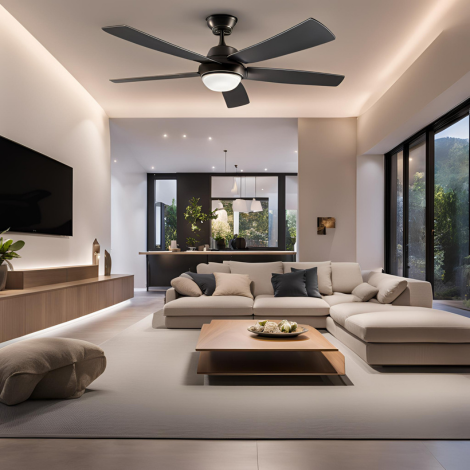Things to Consider When Choosing Ceiling Fan
Choosing the best ceiling fan for your home is not just about finding something that moves air. A well-chosen ceiling fan can enhance your comfort, help save on energy bills, and even add a stylish touch to your living space. However, with so many types, sizes, and features available, selecting the perfect one can feel overwhelming. This guide will walk you through everything you need to know to pick the best ceiling fan for your needs and preferences.
Consider the Room Size: Fan Size Matters
One of the most critical factors in choosing the best ceiling fan is matching the size of the fan to the size of the room. A fan that’s too small won’t effectively circulate air, while one that’s too large might overpower the space.
Here’s a simple rough estimate guide to help you determine the right fan size:
- Small Rooms: A fan with a blade span of ~29-36 inches works best. Perfect for smaller spaces like bathrooms, laundry rooms, or walk-in closets.
- Medium Rooms: Choose a fan with a blade span of ~42-48 inches. Ideal for bedrooms, home offices, or kitchens.
- Large Rooms: A fan with a blade span of ~50-56 inches provides optimal airflow. Best for living rooms, dining rooms, or larger bedrooms.
- Great Rooms: For very large areas like open-plan living spaces or large garages, opt for a fan with a blade span of ~60 inches or more. You may also consider installing more than one fan for efficient coverage.
Room Style: Finding the Perfect Look
Ceiling fans are not just functional—they can also complement your room's aesthetic. Consider the style, finish, and blade material of the fan to ensure it fits the overall look of your space.
- Traditional: Fans with wood-finish blades and ornate details pair well with traditional or classic interiors.
- Modern/Contemporary: Look for sleek designs with metal finishes or minimalist features for modern spaces. Fans with straight, clean lines or innovative shapes work well in contemporary homes.
- Rustic/Farmhouse: For rustic or farmhouse-style homes, choose ceiling fans with distressed wood finishes, natural tones, or industrial-inspired designs.
- Tropical/Coastal: If you’re decorating a beach house or want a tropical vibe, look for fans with bamboo, rattan, or palm leaf-inspired blades.
- Outdoor Fans: For patios, porches, or outdoor living areas, select a fan that is damp- or wet-rated. These come in styles designed to blend seamlessly with nature-inspired or outdoor decor.
Fan Motor: Energy Efficiency and Quiet Operation
The motor is the heart of your ceiling fan. A high-quality motor ensures quiet operation, good airflow, and energy efficiency. Here are the two main types of motors to consider:
AC (Alternating Current) Motors: These are the most common motors found in ceiling fans. They are affordable and reliable but can be slightly noisier than DC motors.
DC (Direct Current) Motors: DC motors are more energy-efficient, they us less electricity, and are quieter than AC motors. They also offer more speed options and smoother operation, making them a popular choice for homeowners looking for efficiency and performance.
Blade Pitch and Material: Maximizing Airflow
Blade pitch refers to the angle of the fan blades. A steeper blade pitch moves more air, but the motor must be powerful enough to handle it. Fans with lower blade pitches may struggle to circulate enough air, particularly in larger rooms.
- Blade Materials: Fan blades are made from a variety of materials, including wood, metal, or plastic. The material affects both the fan's appearance and its durability:
- Wood: Offers a classic, warm look and works well in indoor spaces.
- Metal: Ideal for modern designs but can be noisier at higher speeds.
- Plastic/ABS Blades: These are durable and often used in outdoor fans because they withstand moisture and humidity.
Features: Lights, Controls, and More
Modern ceiling fans come with a variety of additional features that can enhance convenience, comfort, and functionality.
Lighting: Many ceiling fans include a built-in light kit, making them a dual-purpose fixture. Some fans allow you to add a light kit if needed. Choose between LED, CFL, or incandescent bulbs based on your lighting preferences. LED lights are the most energy-efficient option.
Remote Control: Ceiling fans with remote controls or wall-mounted controls allow you to adjust the speed, direction, and lighting from anywhere in the room. This feature is especially convenient in bedrooms and larger spaces.
Smart Fans: If you're into smart home technology, some ceiling fans can be integrated with home automation systems, enabling you to control the fan via smartphone apps, voice commands (Alexa, Google Home), or timers.
Reversible Motor: Many ceiling fans come with a reversible motor, allowing you to change the direction of the blades. In the summer, the fan should rotate counterclockwise to create a cooling breeze. In the winter, reverse the direction clockwise to help push warm air down from the ceiling, making your heating more efficient.
Conclusion: The Key to Choosing the Perfect Ceiling Fan
Choosing the best ceiling fan involves more than just picking a design you like. To get the most out of your fan, it’s essential to consider the room size, ceiling height, fan motor, blade angle, and any additional features like lighting or smart controls. By finding the right balance of functionality, style, and energy efficiency, you’ll end up with a ceiling fan that not only enhances comfort but also adds a touch of elegance to your space.
Have you decided which ceiling fan is best for your home? Browse through our wide Ceiling Fans range.











